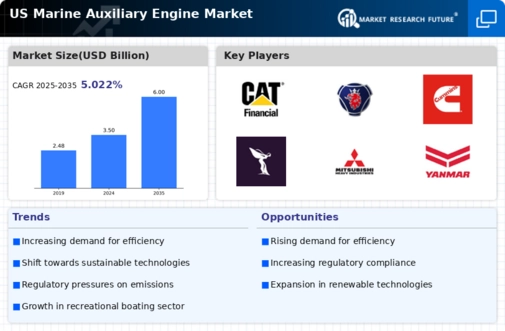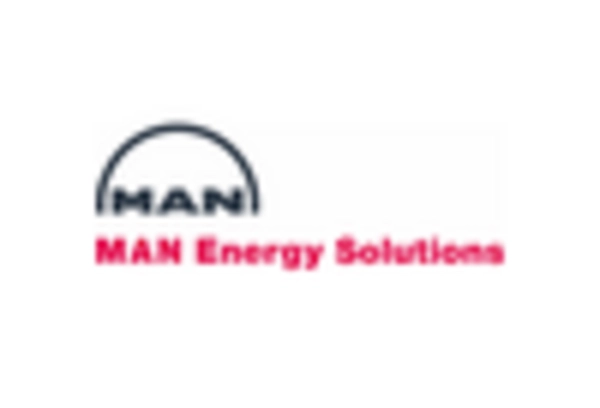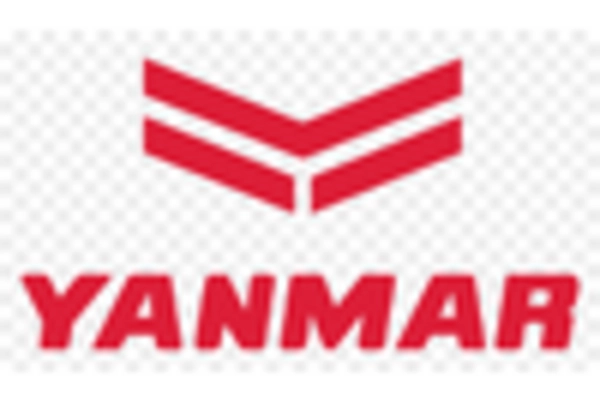Growth of the Shipping Industry
The marine auxiliary-engine market closely follows the growth of the shipping industry, which is experiencing a resurgence in demand. Factors such as increased global trade and the expansion of e-commerce are driving the need for efficient shipping solutions. As shipping volumes rise, so does the demand for auxiliary engines that can support larger vessels and more complex operations. The market is projected to grow in tandem with the shipping industry, with estimates suggesting a compound annual growth rate (CAGR) of 8% over the next five years. This growth presents opportunities for manufacturers to innovate and cater to the evolving needs of the shipping sector.
Investment in Marine Infrastructure
Investment in marine infrastructure is a pivotal driver for the marine auxiliary-engine market. The US government has been allocating substantial funds towards upgrading ports and shipping facilities, which in turn stimulates demand for auxiliary engines. Enhanced infrastructure facilitates more efficient shipping operations, necessitating the use of advanced marine engines. The market is likely to benefit from these investments, as they create a favorable environment for growth. Projections indicate that infrastructure investments could lead to a market expansion of approximately 12% in the coming years, as stakeholders seek to capitalize on improved operational capabilities.
Regulatory Compliance and Standards
The marine auxiliary-engine market is significantly influenced by stringent regulatory compliance and standards imposed by governmental bodies. In the US, the Environmental Protection Agency (EPA) has established regulations aimed at reducing emissions from marine engines. These regulations compel manufacturers to innovate and develop engines that meet or exceed these standards. As a result, the market is witnessing a shift towards cleaner and more efficient technologies. The demand for compliant engines is expected to grow, with projections indicating a potential increase in market size by approximately 15% over the next five years. This regulatory landscape not only drives innovation but also shapes the competitive dynamics within the marine auxiliary-engine market.
Rising Demand for Energy Efficiency
Energy efficiency is becoming a critical driver in the marine auxiliary-engine market. As fuel prices continue to fluctuate, operators are increasingly seeking engines that offer better fuel economy and lower operational costs. The market is responding to this demand by introducing advanced engine designs that optimize fuel consumption. Reports suggest that energy-efficient engines can reduce fuel costs by up to 20%, making them attractive to ship operators. Furthermore, the push for sustainability aligns with this trend, as energy-efficient engines contribute to lower emissions. Consequently, the marine auxiliary-engine market is likely to experience robust growth as stakeholders prioritize energy efficiency in their operations.
Technological Integration in Marine Operations
The integration of advanced technologies in marine operations is reshaping the marine auxiliary-engine market. Innovations such as IoT, AI, and big data analytics are being utilized to enhance engine performance and operational efficiency. These technologies enable real-time monitoring and predictive maintenance, which can significantly reduce downtime and maintenance costs. The marine auxiliary-engine market is witnessing a surge in demand for engines equipped with these technologies, as they offer improved reliability and performance. It is estimated that the adoption of smart technologies could lead to a market growth of around 10% annually, as operators seek to leverage these advancements for competitive advantage.

















Leave a Comment